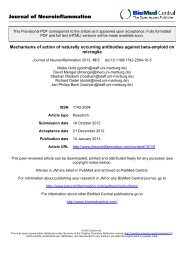View PDF - Journal of Neuroinflammation
View PDF - Journal of Neuroinflammation
View PDF - Journal of Neuroinflammation
You also want an ePaper? Increase the reach of your titles
YUMPU automatically turns print PDFs into web optimized ePapers that Google loves.
Krstic et al. <strong>Journal</strong> <strong>of</strong> <strong>Neuroinflammation</strong> 2012, 9:151 Page 18 <strong>of</strong> 23<br />
http://www.jneuroinflammation.com/content/9/1/151<br />
(See figure on previous page.)<br />
Figure 8 Aggravated Tau pathology after systemic infection in adult mice. Representative images <strong>of</strong> coronal brain sections obtained from<br />
(A,D) NP (NaCl at gestation day (GD)17, PolyI:C at 12 months) and (B,E,F) PP mice (PolyI:C at GD17 and at 12 months), processed for (A,B)<br />
immunoperoxidase and (D-F) immun<strong>of</strong>luorescence staining using anti-phosphorylated Tau T205 antibodies. (A,B) Images are color-coded for visual<br />
display, with white/yellow indicating highest and blue/purple lowest staining intensity. (C) Quantitative analysis <strong>of</strong> the optical density (OD) <strong>of</strong><br />
pTau IR in the hippocampus <strong>of</strong> all treatment groups. Values represent mean OD values corrected for non-specific background labeling<br />
(mean ± SEM), n = 6 to 7. **P < 0.01, *P < 0.05; statistical significance based on ANOVA/Fisher’s LSD post-hoc analysis. (D-F) Increase in pTau IR in<br />
CA1 is accompanied by mis-sorting into dendrites and intraneuronal aggregation in non-transgenic PP mice. (F) Enlarged view <strong>of</strong> the CA1<br />
stratum lacunosum moleculare subfield showing the typical somatic pTau aggregation. (G) Biochemical analysis <strong>of</strong> Tau phosphorylation using<br />
anti-paired helical filaments (PHFs), anti-pTau T205 , and anti-total Tau antibodies. Lanes represent individual mice. (H) Quantitative analysis <strong>of</strong> the<br />
immunoreactive signals. Values represent mean relative optical density normalized to β-Actin and expressed in arbitrary units (AU) (mean ± SEM,<br />
n = 6 to 7). **P < 0.01; Mann–Whitney U test. Please note that the pTau T205 antibody was used for (A,B) immunohistochemistry (IHC) and (G)<br />
immunoblotting (IB) experiments. Because this antibody can crossreact with Ser199 in mouse Tau, an epitope that can be detected with the<br />
AT100 (PHF) antibody [63], the increase <strong>of</strong> pTau IR in (A,B) is potentially due to an increase in aggregated pTau in sections. (I-J) Anti-pTau T205 IR<br />
in the ventral hippocampus <strong>of</strong> 15-month-old 3xTg-AD mice injected with NaCI or PolyI:C at 4 months. Insets show higher magnifications <strong>of</strong> the<br />
cortical areas (asterisk) with low transgene expression, and indicate formation <strong>of</strong> distinct neur<strong>of</strong>ibrillary tangle-like structures after a single<br />
systemic infection in transgenic AD mice. Scale bars: (A) = 500 μm, (D)=30 μm, (F)=5 μm, (I, inset) = 50 μm, (J) = 500 μm.<br />
[23] and challenged them with PolyI:C at the pre-plaque<br />
stage. Subsequent analysis at 15 months showed a dramatic<br />
increase in Aβ plaque deposition in the entire<br />
hippocampus <strong>of</strong> the PolyI:C-treated mice. These data are<br />
in line with recent findings <strong>of</strong> accelerated Aβ pathology<br />
in transgenic AD mice after induction <strong>of</strong> osteoarthritis,<br />
which is accompanied by significant upregulation <strong>of</strong><br />
inflammation-related genes and astrocyte and microglial<br />
activation in the brain [56]. Importantly, inflammationinduced<br />
plaques contained significant amounts <strong>of</strong> proteolytic<br />
APP fragments, as seen in double immunechallenged<br />
WT mice (Figure 9A-D). These APP-derived<br />
aggregates were surrounded by human Aβ peptides,<br />
showing a striking similarity to the morphology <strong>of</strong> Aβ<br />
plaques seen in human patients with AD (Figure 9E-F).<br />
Importantly, other laboratories have also reported rodent<br />
APP in the core <strong>of</strong> Aβ deposits in variuos transgenic<br />
AD mouse strains [55,57]. Hence, we conclude<br />
that accumulation <strong>of</strong> APP and its N-terminus-containing<br />
fragments precedes the formation <strong>of</strong> senile plaques, representing<br />
a crucial and conserved precursor stage <strong>of</strong> this<br />
typical neuropathologic hallmark.<br />
In agreement with recent experimental evidence showing<br />
that hyperphosphorylated, non-fibrillary Tau may have<br />
a key role in eliciting behavioral impairments in vivo<br />
[34,58], we were able to show in this study that the Tau<br />
hyperphosphorylation and mislocalization into somatodendritic<br />
compartments is accompanied by severe deficit<br />
in prenatally challenged mice compared with salinetreated<br />
controls. However, it would be interesting to confirm<br />
if a second immune challenge during aging results in<br />
progressive decline <strong>of</strong> cognitive functions, as indicated by<br />
the recent findings in patients with AD, providing evidence<br />
that acute and chronic systemic inflammation is<br />
associated with an increase in cognitive decline [42]. Although<br />
we did not observe the formation <strong>of</strong> NFTs in<br />
immune-challenged mice, a second immune challenge in<br />
our model elicited the intraneuronal aggregation <strong>of</strong> Tau,<br />
probably involving the formation <strong>of</strong> PHFs. Further studies<br />
will be required to characterize the nature <strong>of</strong> these and<br />
potentially other phosphorylated epitopes affected by the<br />
chronic inflammatory state. We have recently shown that<br />
NFT-like structures can form in the brain <strong>of</strong> AD mice<br />
lacking tau transgene expression, by genetic reduction <strong>of</strong><br />
the reelin gene [27]. Interestingly, formation <strong>of</strong> these<br />
NFT-like structures was associated with a high Aβ plaque<br />
burden, and prominent neuroinflammation and neurodegeneration<br />
[27]. Hence, it is reasonable to suggest that the<br />
formation <strong>of</strong> PHFs we saw in double immune-challenged<br />
WT mice would eventually develop into NFTs at older<br />
age and later stages <strong>of</strong> the disease.<br />
In summary, and based on the results presented and<br />
discussed here, we propose a model (Figure 9G) in<br />
which the mendelian mutations underlying familial AD<br />
cause pr<strong>of</strong>ound changes in APP metabolism, inducing a<br />
neuroinflammatory response capable <strong>of</strong> driving and aggravating<br />
AD neuropathology during aging. Repeated<br />
systemic immune challenges, by contrast, induce<br />
chronic neuroinflammation and may accelerate senescence<br />
<strong>of</strong> microglia cells. Reduction in their neuroprotective<br />
function is expected to impair both APP and<br />
pTau homeostasis. This in turn could trigger a vicious<br />
cycle that will lead, over the course <strong>of</strong> aging, to the formation<br />
<strong>of</strong> senile Aβ plaques and NFTs, induce degeneration,<br />
and ultimately result in clinical dementia. We<br />
suggest, therefore, that systemic infections and persistent<br />
neuroinflammatory conditions represent major risk<br />
factors for the development <strong>of</strong> sporadic AD in older<br />
persons. Importantly, our model complements the<br />
long-standing amyloid hypothesis <strong>of</strong> AD [59,60], and is<br />
in accordance with the recent proposal to revise the<br />
current view on the etiology <strong>of</strong> sporadic AD [61].




